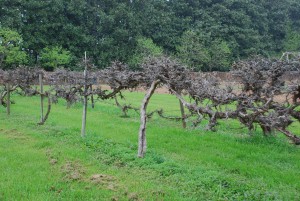Gardeners in Southern Appalachian region (USDA zones 6 and 7) can now grow seedless table grapes. “The quality of the new table grape varieties is terrific, rivaling those we currently buy at our local supermarkets from California”, according to Dr. David Lockwood, Universities of Tennessee and Georgia Extension Fruit Specialist.
Eastern table grapes are hybrids of V. vinifera and V. labrusca. V. labrusca provides better winter hardiness, reduced disease susceptibility, and a fruity or “foxy” flavor similar to the old seeded variety ‘Concord’. The berry texture is crisp like the non-slipskin V. vinifera sold in supermarkets.
His recommended list of hardy table grapes includes:
‘Jupiter’ – large reddish blue (blue at fully maturity); flesh is semi crisp, thin skinned; harvest in late July.
‘Neptune’ – medium white (yellow-green skin) fruity and pleasant; harvest in early September.
‘Saturn’ – medium red berry with a sweet and fruity flavor; harvest in late July.
‘Vanessa’ – firm red berries with a fruity taste; stores well after harvest; ripens in early to mid September.
‘Marquis’– is slip-skin type having an excellent Labrusca fruity flavor; ripens in early to mid September.
The new varieties were developed at the Geneva Experiment Station in New York State, and Arkansas Experiment Station in Fayetteville, AR, and the Vineland Experiment Station in Ontario, Canada.
These grape varieties are susceptible to serious foliar fungal diseases as black rot, downy, powdery mildews and anthracnose. They require timely fungicide controls in the spring and summer months.


 Posted in
Posted in 
